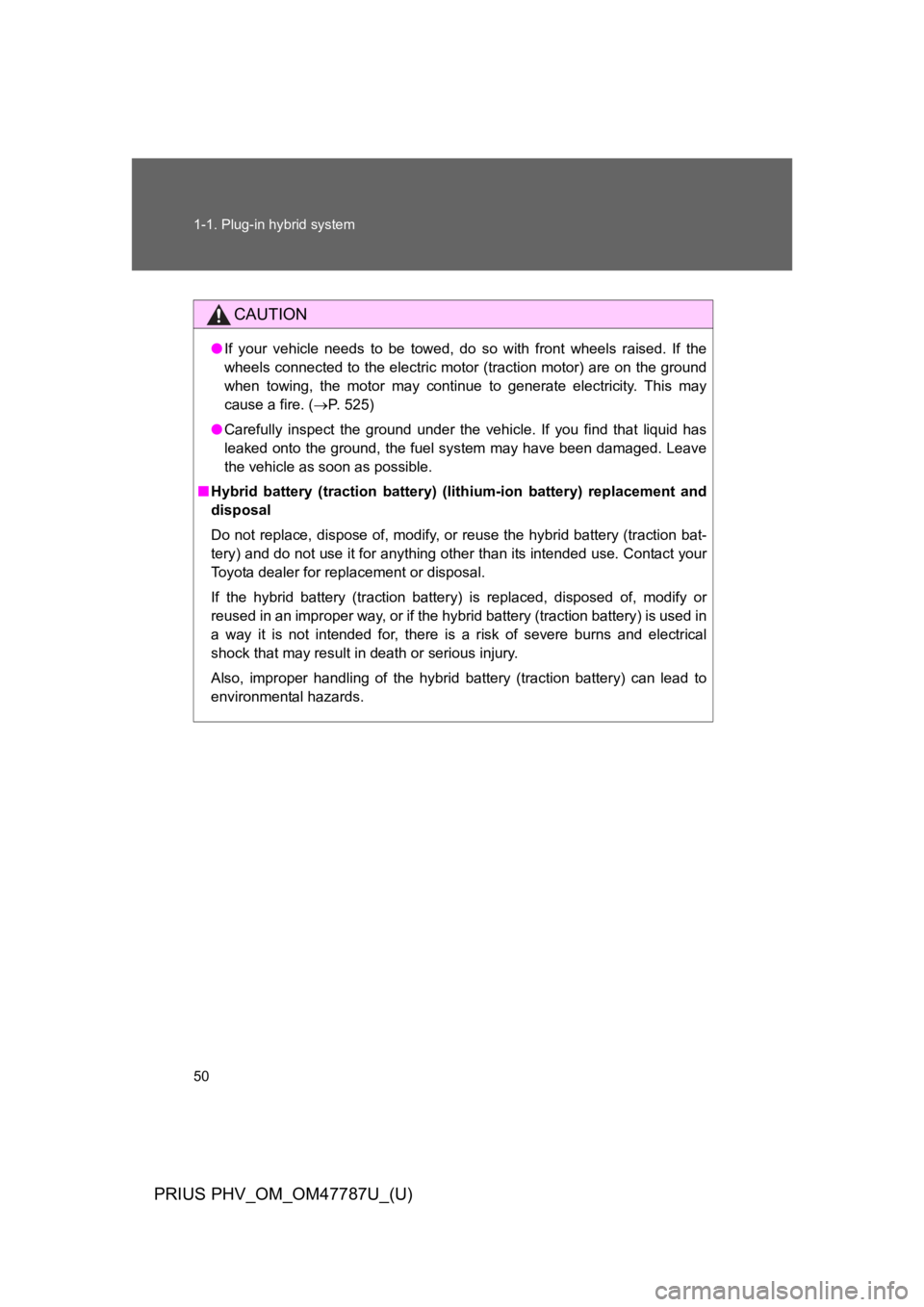Page 8 of 704
8
1. Charging operation
PRIUS PHV_QG_OM47788U_(U)
■After charging
Pull the charging connector
towards you while pressing the
latch release button.
If the charging connector is dis-
connected during charging (while
the charging indicator is on),
charging will be interrupted.
Attach the charging connector cap.
Close the charging port lid.
Remove the plug from the outlet when the charging equip-
ment will not be used for a prolonged period of time.
Hold the body of the plug when removing.
Make sure to put the cable away immediately after disconnecting.
When leaving the plug inserted, inspect the plug and connector once
a month to check if dirt or dust has accumulated.
STEP1
STEP2
STEP3
STEP4
Page 33 of 704
33
3. Basic operation
PRIUS PHV_QG_OM47788U_(U)
■Canceling and resuming the constant speed control
Pulling the lever toward you
cancels the constant speed
control.
The speed setting is also can-
celed when the brakes are
applied.
Pushing the lever up resumes
the constant speed control.
Resuming is available when the
vehicle speed is more than
approximately 25 mph (40 km/h).
ITO24P106
■Cruise control can be set when
●The shift position is in D.
●Ve h i c l e s p e e d i s a b o v e a p p r o x i m a t e l y 2 5 m p h ( 4 0 k m / h ) .
Page 77 of 704

50
1-1. Plug-in hybrid system
PRIUS PHV_OM_OM47787U_(U)
CAUTION
●If your vehicle needs to be towed, do so with front wheels raised. If the
wheels connected to the electric motor (traction motor) are on the ground
when towing, the motor may continue to generate electricity. This may
cause a fire. (→P. 5 2 5 )
●Carefully inspect the ground under the vehicle. If you find that liquid has
leaked onto the ground, the fuel system may have been damaged. Leave
the vehicle as soon as possible.
■Hybrid battery (traction battery) (lithium-ion battery) replacement and
disposal
Do not replace, dispose of, modify, or reuse the hybrid battery (traction bat-
tery) and do not use it for anything other than its intended use. Contact your
To y o t a d e a l e r f o r r e p l a c e m e n t o r d i s p o s a l .
If the hybrid battery (traction battery) is replaced, disposed of, modify or
reused in an improper way, or if the hybrid battery (traction battery) is used in
a way it is not intended for, there is a risk of severe burns and electrical
shock that may result in death or serious injury.
Also, improper handling of the hybrid battery (traction battery) can lead to
environmental hazards.
Page 112 of 704
85
1-2. Charging
1
Before driving
PRIUS PHV_OM_OM47787U_(U)
■After charging
Pull the charging connector
towards you while pressing
the latch release button.
If the charging connector is
disconnected during charging
(while the charging indicator is
on), charging will be inter-
rupted.
Attach the charging connector
cap.
Close the charging port lid.
STEP 1
STEP 2
STEP 3
Page 146 of 704

119
1-4. Opening, closing and locking the doors
1
Before driving
PRIUS PHV_OM_OM47787U_(U)
■Conditions affecting operation
The smart key system, wireless remote control and immobilizer system use
weak radio waves. In the following situations, the communication between
the electronic key and the vehicle may be affected, preventing the smart key
system, wireless remote control and immobilizer system from operating
properly. (Ways of coping: →P. 5 9 1 )
●When the electronic key battery is depleted
●Near a TV tower, electric power plant, gas station, radio station, large dis-
play, airport or other facility that generates strong radio waves or electri-
cal noise
●When carrying a portable radio, cellular phone, cordless phone or other
wireless communication devices
●When the electronic key is in contact with, or is covered by the following
metallic objects
•Cards to which aluminum foil is attached
•Cigarette boxes that have aluminum foil inside
•Metallic wallets or bags
•Coins
•Hand warmers made of metal
•Media such as CDs and DVDs
●When other wireless key (that emit radio waves) is being used nearby
●When carrying the electronic key together with the following devices that
emit radio waves
•Another vehicle’s electronic key or a wireless key that emits radio
waves
•Personal computers or personal digital assistants (PDAs)
•Digital audio players
•Portable game systems
●If window tint with a metallic content or metallic objects are attached to
the rear window
Page 176 of 704
149
1
1-5. Adjustable components (seats, mirrors, steering wheel)
Before driving
PRIUS PHV_OM_OM47787U_(U)
Rear seats
Before folding down the seatbacks
Park the vehicle in a safe place.
Apply the parking brake firmly and shift the shift position to P.
(→P. 2 4 8 )
Adjust the position of the front seat and the angle of the seat-
back. (→P. 1 4 6 )
Depending on the position of the front seat, if the seatback is folded
backward, it may interfere with the operation of the rear seat.
Stow the buckle of the seat belts.
Lower the head restraint of the rear seat. (→P. 1 5 2 )
Ve h i c l e s w i t h a n a r m r e s t : St o w t h e a r m r e s t o f t h e r e a r s e a t i f i t
is pulled out. (→P. 3 9 9 )
This step is not necessary when operating the driver’s side seat only.
The seatbacks can be folded down.
STEP 1
STEP 2
STEP 3
STEP 4
STEP 5
Page 181 of 704
154
1-5. Adjustable components (seats, mirrors, steering wheel)
PRIUS PHV_OM_OM47787U_(U)
■Installing the head restraints
Front and rear center seats
Rear outside seats
■Adjusting the height of the head restraints
■Adjusting the rear center seat head restraint
Always raise the head restraint one level from the stowed position when
using.
Align the head restraint with the installa-
tion holes and push it down to the lock
position.
Press and hold the lock release button
when lowering the head restraint.Lock
release
button
Align the head restraint with the installa-
tion holes and push it down to the lowest
lock position.
Make sure that the head restraints are
adjusted so that the center of the head
restraint is closest to the top of your ears.
Page 219 of 704

192
1-9. Safety information
PRIUS PHV_OM_OM47787U_(U)
CAUTION
■SRS airbag precautions
Observe the following precautions regarding the SRS airbags.
Failure to do so may cause death or serious injury.
●The driver and all passengers in the vehicle must wear their seat belts
properly.
The SRS airbags are supplemental devices to be used with the seat belts.
●The SRS driver airbag deploys with considerable force, and can cause
death or serious injury especially if the driver is very close to the airbag.
The National Highway Traffic Safety Administration (NHTSA) advises:
Since the risk zone for the driver’s airbag is the first 2 - 3 in. (50 - 75 mm)
of inflation, placing yourself 10 in. (250 mm) from your driver airbag pro-
vides you with a clear margin of safety. This distance is measured from the
center of the steering wheel to your breastbone. If you sit less than 10 in.
(250 mm) away now, you can change your driving position in several
ways:
•Move your seat to the rear as far as you can while still reaching the
pedals comfortably.
•Slightly recline the back of the seat.
Although vehicle designs vary, many drivers can achieve the 10 in.
(250 mm) distance, even with the driver seat all the way forward, sim-
ply by reclining the back of the seat somewhat. If reclining the back of
your seat makes it hard to see the road, raise yourself by using a firm,
non-slippery cushion, or raise the seat if your vehicle has that feature.
•If your steering wheel is adjustable, tilt it downward. This points the air-
bag toward your chest instead of your head and neck.
The seat should be adjusted as recommended by NHTSA above, while still
maintaining control of the foot pedals, steering wheel, and your view of the
instrument panel controls.